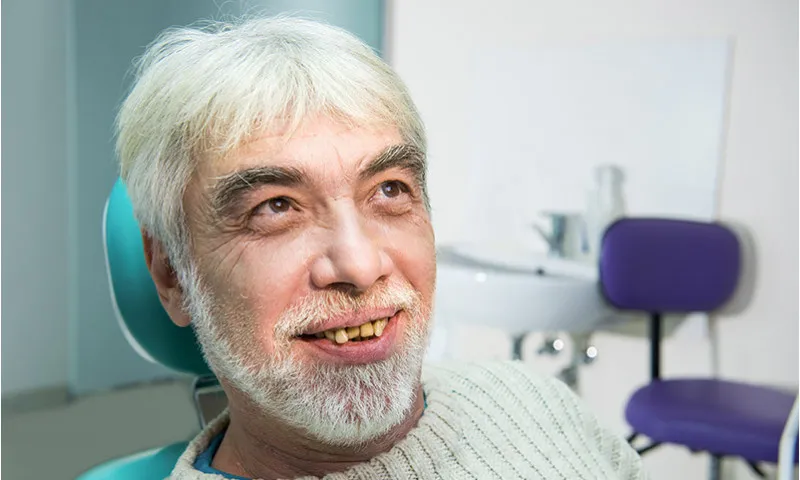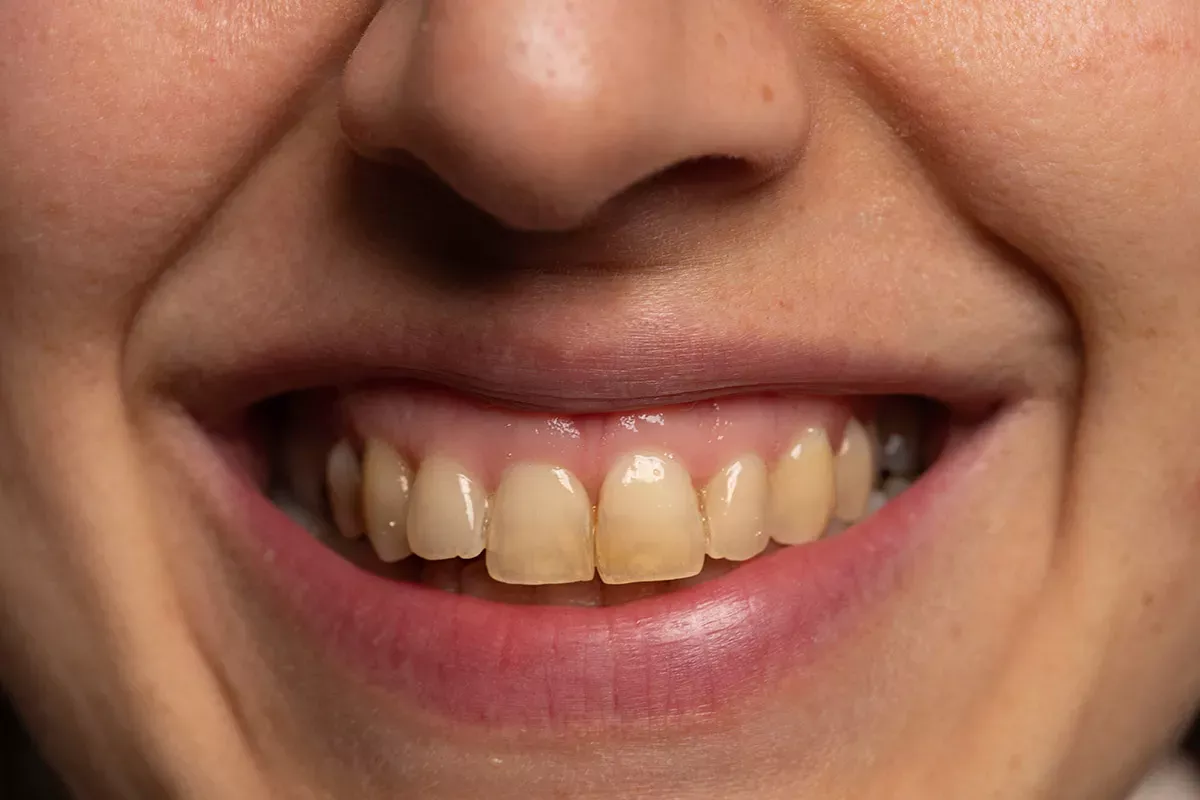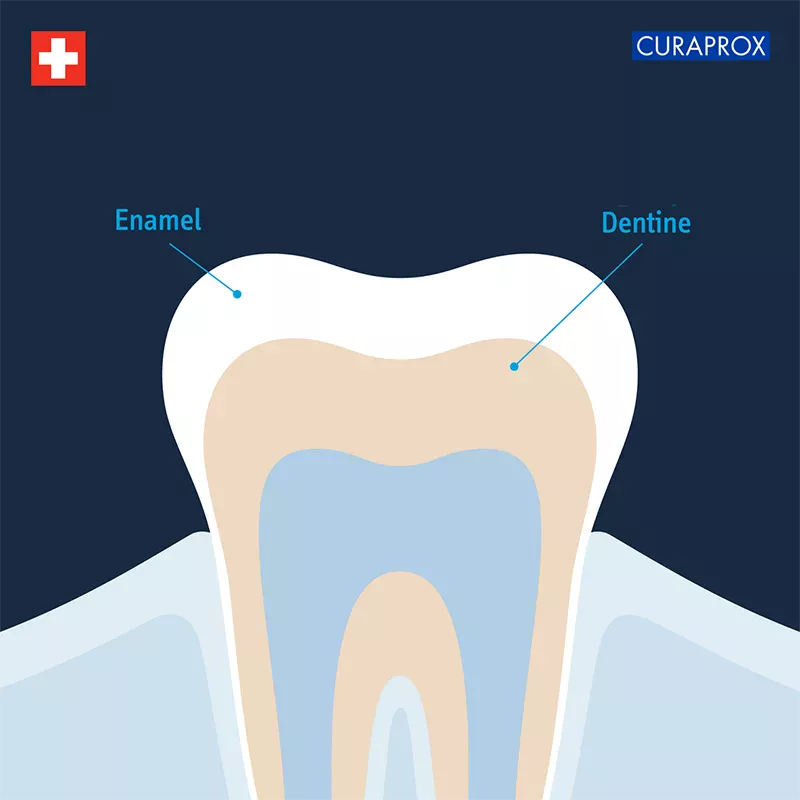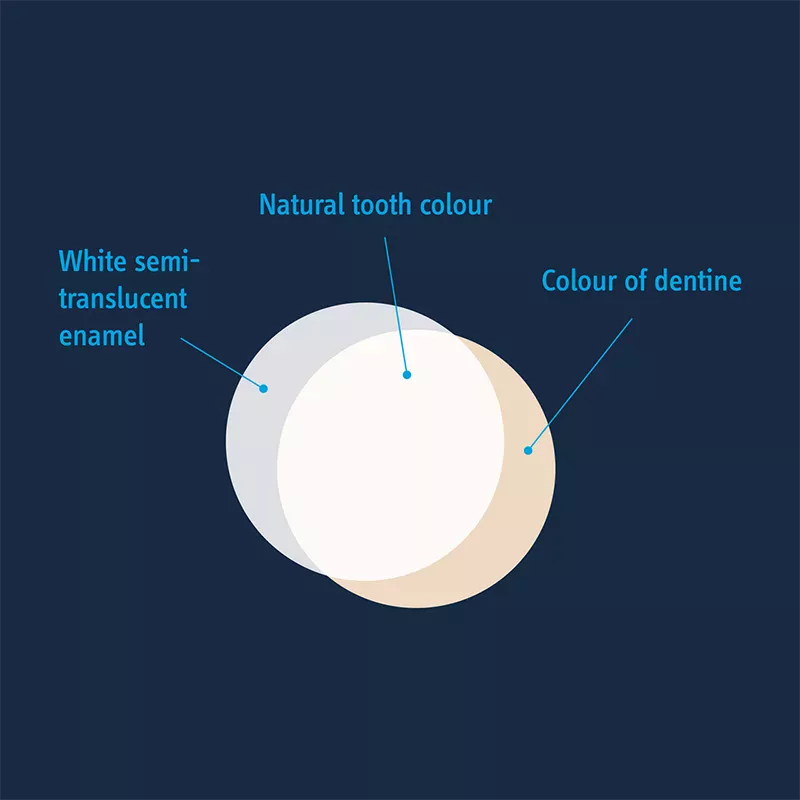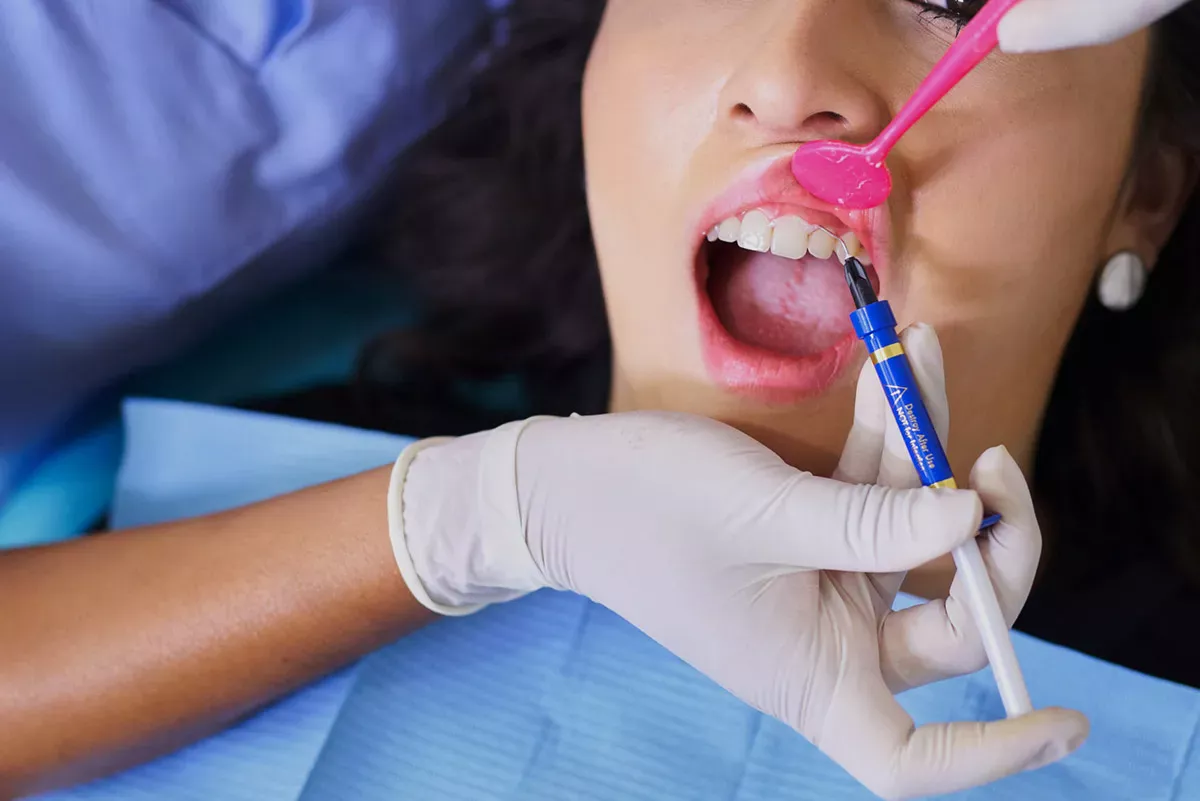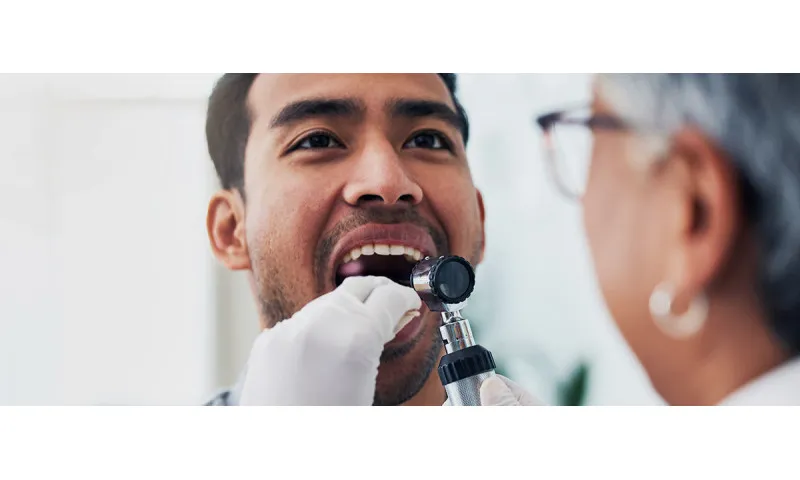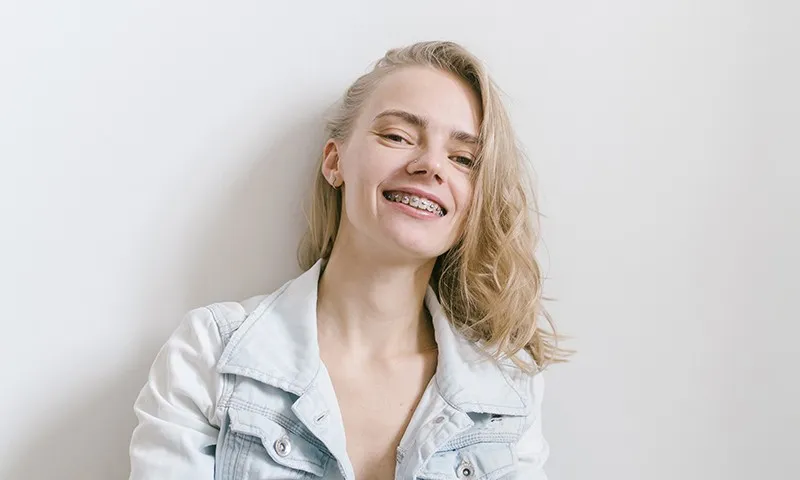What are the effects of yellow teeth?
In actually every culture, a radiant white smile is considered the ideal of beauty, along with straight and well-formed teeth. People with yellow teeth often feel uncomfortable and their self-confidence suffers as a result. Yellow teeth can also limit social life, so that people with yellow teeth, for example, do not like to laugh with their mouths open and instead only laugh with their hands in front of them.
However, this does not only have a negative effect on self-perception. Both in love and in professional life, people with white teeth are more successful. This is the result of various studies in Germany, England and the USA. Especially women under 30 attach great importance to white teeth when choosing a partner. While yellow teeth are perceived as unkempt and unattractive, white teeth stand for self-discipline and health consciousness. A radiant smile is therefore a real status symbol.
Fortunately, yellow teeth don't have to be a permanent condition. Here you can find out where your yellow teeth come from and how to get rid of them so that you can laugh heartily and carefree again.
Causes: Where do yellow teeth come from?
Even though discolouration can appear unkempt to other people, it does not necessarily have to be due to poor dental and oral hygiene. In technical terms, a distinction is made between intrinsic and extrinsic discolouration of yellow teeth. Intrinsic discolouration occurs inside the tooth - often in childhood during development or later due to injuries or wear. Extrinsic discolouration is when colour particles are deposited on the enamel. Both types of discolouration can have different causes. So if you've always wondered why your teeth are yellow, here's the answer.
Genetics
The natural tooth colour differs from person to person. Everything is represented from pearly white to ivory to matt grey and reddish brown. It depends not only on the basic shade of the tooth bone, but also on how thick the enamel around it is. The thicker the enamel layer, the whiter the teeth appear. So some people naturally have whiter teeth than others. The hereditary shade can also appear differently light or dark in refracted light.
Are yellow teeth healthy?
Yellow teeth are not bad. In fact, real teeth are almost never really white, but rather ivory-coloured. That's why we often perceive heavily bleached teeth as unnatural. Yellow teeth can even be healthier than white teeth. Of course, this is not true if the cause of the yellowing is smoking or poor dental hygiene, but if your teeth simply have a naturally more yellowish tone. Then it is a sign of a high calcium content.
Good to know:
Curaprox's 'Black is white' and 'Be you' toothpastes place an optical blue filter over your teeth, which ensures that yellow light is not reflected on the tooth surface. This makes your teeth look much whiter.
Smoking
Smoking is not only bad for your general health, but also leaves yellow stains on your teeth. This is mainly due to toxic substances such as tar, which are deposited in the oral cavity when tobacco is burnt and form a veil over the teeth. E-cigarettes do not contain these substances, but nicotine also has a staining effect. So if you want to switch from classic cigarettes to e-cigarettes, your teeth will discolour less.
But it's even better to quit smoking altogether. Smoking not only discolours your teeth, it can cause a lot of damage to your mouth: from dry mouth to tongue coating to an increased risk of dental disease, inflammation and even cancer.
Colouring food
Yellow discolouration can also occur if you frequently eat foods that have a strong staining effect. The colour particles settle on the tooth surface and even penetrate the enamel over time. The result is brownish-yellow teeth.
Foods that are highly colouring include:
- Coffee
- Tea
- Red wine
- Soft drinks (for example cola)
- Ketchup and tomato sauce
- Balsamic vinegar
- Curry
- Berries
- Beetroot
Good to know:
If you often drink coffee or tea, chewing gum between meals can help prevent discolouration. The 'Black is white' chewing gum from Curaprox not only protects against caries thanks to xylitol, but also gently whitens your teeth thanks to the activated charcoal it contains.
Wear
Tooth enamel is the hard, white substance that makes up the surface of the tooth. Underneath is the dentin, which varies in colour from person to person - from deep yellow to reddish brown. As the enamel becomes thinner, the natural colour of the dentin shines through more and more and the teeth look more yellow.
Yellow teeth in old age
It is quite normal that our teeth become yellower in the course of life because the enamel layer becomes slowly but gradually thinner through chewing. Acidic foods also attack the enamel.
Teeth grinding
Some people subconsciously grind their teeth when they are under stress - especially during sleep. The friction wears down the enamel faster than usual and this can lead to yellow teeth in severe cases.
Dental injuries
Severe damage to the teeth can break the enamel and thus damage the inside of the teeth, which can lead to intrinsic discolouration.
Lack of or incorrect dental hygiene
It's pretty obvious that brushing too infrequently can be a reason for yellow discolouration. However, if you have yellow teeth despite brushing, the wrong brushing technique may be behind it.
Yellow teeth due to poor oral hygiene
If you brush your teeth too infrequently, you will develop plaque and tartar. Especially if you have yellow teeth on your gums or yellow spaces between your teeth, this may be a result of poor dental hygiene. This not only looks unsightly, but can also lead to serious dental diseases such as tooth decay or periodontal disease. Plaque and tartar are caused by bacteria that make themselves at home in food residues.
Yellow teeth due to incorrect technique
Over-ambitious dental care can also lead to yellow teeth. If you use too much pressure, a toothbrush that is too hard and a coarse-grained toothpaste, you will grind away the enamel. The thinner the enamel, the more the yellowish-brownish dentin will show through.
You can find detailed instructions on what you should pay attention to when brushing your teeth and what the right technique is here:
Instructions: The best technique for brushing your teeth
Yellow teeth due to mouth rinses with chlorhexidine
Antibacterial mouthwashes with chlorhexidine, such as Chlorhexamed, have an unpleasant side effect: a yellowish discolouration of the teeth. However, in some situations - for example, before or after dental surgery or in the case of inflammation in the mouth - it is necessary to use such a mouthwash. If you brush your teeth extra thoroughly, you can clean the yellow teeth directly. Any remaining discolouration can be removed by your dentist during a professional dental cleaning.
Good to know:
With Perio plus mouth rinses from Curaprox, discolouration is very limited. Since Citrox® enhances the effect of chlorhexidine, the mouth rinses only require a smaller amount of the staining agent. However, the effect remains just as strong.
Stained teeth due to fluoride
Fluoride is a very effective substance to protect against caries, but it is possible to overdo it. If parents are too good to their children and give fluoride tablets in addition to fluoride toothpaste, and this is combined with fluoridated salt or fluoride-containing tap water, fluorosis can occur. This is when the body absorbs too much fluoride and reacts with white or yellow spots - especially on the incisors and canines. If you live in a region with a particularly high fluoride content in the tap water, a fluoride-free toothpaste may be the right choice.
Diseases
Yellow teeth can also be caused by diseases. The following diseases can cause discolouration:
- Coeliac disease / gluten intolerance
- Alzheimer's
- Bronchial asthma
- Congenital porphyria
- Bile duct disorders
- Neonatal hepatitis
- Pulp roses
In addition, diseases that affect the oral flora - such as diabetes - favour yellow teeth without being a direct symptom of the disease.
Medicines
Medicines can also cause yellow teeth. Antibiotics in particular are known to cause discolouration.
Yellow teeth due to antibiotics: What to do?
If antibiotics containing tetracycline are taken during tooth development, they can cause irreversible brown-yellow discolouration. Therefore, women should not take this type of antibiotic during pregnancy. Caution is also advised for children under eight years of age, because taking them can cause discolouration of the permanent teeth.
Other classes of antibiotics can also cause yellow teeth and other discolouration: phenoxymethylpenicillin turns teeth yellow-brown, while amoxicillin can discolour teeth grey. Cotrimoxazole, erythromycin, metronidazole and cefaclor can also discolour teeth. However, this discolouration is usually not permanent. You can get your yellow teeth white again by brushing your teeth thoroughly or having your teeth professionally cleaned.
Other medicines
There are a number of medicines that dry out the mouth and provide an ideal breeding ground for bacteria. This causes plaque to form more quickly.
These medicines affect the oral flora:
- Psychotropic drugs
- High blood pressure medication
- Neuroleptics
- Antihistamines
- Appetite suppressant
- Diarrhoea remedy
- Chemo therapies for the treatment of cancer
Dental treatments
Certain dental treatments can also be the cause of discolouration. Root canal treatment, for example, sometimes results in grey discolouration because the tooth is no longer vital.
When young people wear braces, thorough oral hygiene is especially important. Otherwise, plaque will quickly accumulate around the brackets, which can also turn yellow. If you don't remove these deposits, they can attack the enamel and cause tooth decay.
Instructions: Clean fixed braces properly
Calcium deficiency
Yellow teeth are not usually a sign of vitamin deficiency. However, if you have white, yellow or brown spots on your teeth, you may have a calcium deficiency.
Treatment: What to do about yellow teeth?
You are probably asking yourself: "How do you whiten yellow teeth? There are actually a few ways to make yellow teeth white again. In this section we will answer all the burning questions that are on the tip of your tongue: What are the home remedies? What really helps? And when should you go to the dentist?
Do home remedies help with yellow teeth?
There is a lot of information floating around on the internet about how to whiten your teeth naturally. However, caution is advised. Many of the home remedies advertised can do more harm than good.
Baking powder/soda
Baking soda is a classic household remedy when it comes to DIY care products and is often touted as a suitable remedy for yellow teeth. In fact, baking soda causes a chemical reaction in the mouth that dissolves discolouration and whitens the teeth. However, the acid also attacks the tooth enamel and roughens the tooth surface. This makes it easier for plaque to stick and, in the long run, the yellow teeth become worse than before. In addition, the baking soda rubs off the enamel, which in turn causes the naturally yellowish dentin to become more visible.
Salt
Salt crystals can certainly remove coarse stains on teeth, but just like baking soda, they attack the tooth enamel. The stains are not removed by a chemical reaction, but by mechanical scrubbing. Bacteria and other germs can adhere better to the roughened tooth surface. In the end, you not only get more plaque, but also increase the risk of tooth decay.
Lemon juice
The acid in the lemon juice also takes its toll on the tooth enamel by removing important minerals. The tooth not only becomes more susceptible, but also more transparent. This makes the natural yellow hue of the tooth bone even more apparent.
Activated carbon
Activated charcoal has the ability to bind harmful substances and make them harmless. This principle is used in naturopathy, for example, for digestive complaints in the form of activated charcoal tablets. Toxic substances bind to the surface of the activated charcoal and are simply excreted from the body. Activated charcoal works similarly in the mouth: When activated charcoal comes into contact with your teeth, it binds colour particles, bacteria and toxins to itself, which you then simply spit out.
What is important here: If you want to use activated charcoal powder as a home remedy, you should only mix it with water and then apply the paste to your teeth, leave it to work and rinse with water. However, you should not brush your teeth with the mixture, because even activated charcoal in this coarse form can grind down the enamel. If you want to use activated charcoal in a fine form to brush your teeth, you should rather use a special toothpaste with activated charcoal that protects your tooth enamel at the same time.
Good to know:
Curaprox 'Black is white' toothpaste not only contains activated charcoal to bind dyes, bacteria and toxins, but also protects your teeth from decay with three enzymes that are already present in saliva. The activated charcoal is so fine that it does not attack your tooth enamel.
Will brushing make yellow teeth white again?
You've probably asked yourself which toothpaste is the best to use against yellow teeth and whether it's even possible to brush your teeth white. After all, there are lots of toothpastes available in supermarkets, drugstores and online, all promising a bright white smile. So can you brush yellow teeth white? The answer is: yes, but not in every case. And there are also big differences in the long-term effect between different toothpastes.
Whitening toothpastes
It has been scientifically proven that whitening toothpaste can make teeth whiter. The important question here, however, is: how does it do this and is the effect permanently healthy for the teeth? Many conventional toothpastes with a whitening effect rely on aggressive ingredients that abrade the tooth enamel to remove discolouration. Similar to a skin peel, impurities and discolouration are mechanically scrubbed off - along with the tooth enamel. However, there is one important difference: unlike skin, tooth enamel does not grow back. The gums also recede if you scrub them with aggressive agents over a long period of time - and they don't grow back either. This leads to open necks of teeth, which can cause a lot of pain.
Therefore, it is important that you choose a whitening toothpaste that gently whitens your teeth and does not attack the enamel. There is a measurement that tells you exactly how much the toothpaste erodes the enamel: the relative dentin abrasion (RDA). The higher this value, the more the toothpaste attacks the enamel. Whitening toothpastes can reach a value of over 200. Above 100, toothpaste is considered highly abrasive.
Good to know:
The products from the 'Be you' line by Curaprox have a particularly low RDA value of between 30 and 60 and focus on a particularly natural and gentle whitening effect. Hydroxyapatite closes cracks and irregularities in the tooth enamel and thus ensures that colour particles cannot adhere in the first place. By smoothing the tooth surface, the teeth also appear whiter. You can imagine the effect as being similar to that of a room wall: If the surface is completely smooth, it looks whiter than a wall with a granular structure that casts small shadows.
Toothpaste with activated charcoal
The activated charcoal in the toothpaste binds colour particles and also bacteria and toxins to itself so that you can simply spit them out. The particles stick to the activated charcoal because it has a particularly large surface area - one gram of activated charcoal has the same surface area as a football field! This enormous binding power allows you to get rid of yellow teeth without damaging the enamel.
But watch out! If you choose a toothpaste with activated charcoal, you should also pay attention to the RDA value. Even activated charcoal can scratch your tooth enamel if it is not fine enough. For example, Curaprox 'Black is white' activated charcoal toothpaste has an RDA of 90, which is low for a whitening toothpaste. To complement toothpaste with activated charcoal, there are also toothbrushes with bristles coated with activated charcoal to better trap colour particles.
When to see a doctor for yellow teeth?
Yellow teeth are usually harmless. Nevertheless, those affected find them very disturbing. If the yellow discolouration bothers you a lot or has appeared within a short period of time, you should have a dental check-up. Depending on the cause of the yellow teeth, the dentist will suggest a suitable treatment method.
Professional teeth cleaning
If your teeth are yellow because of plaque and tartar build-up, or if you want to remove discolouration caused by other external factors (such as coffee or tea), a professional teeth cleaning can make your smile much whiter. The dentist gently cleans the surface of the teeth with a powder jet that does not damage the enamel. If you have your teeth professionally cleaned once or twice a year - as recommended by dentists - you will prevent heavy deposits from staining your teeth yellow.
Bleaching
If the discolouration is within the enamel or in deeper areas of the teeth, professional tooth cleaning is not enough. If you still want to lighten the yellow teeth, the dentist can perform a so-called bleaching and whiten your teeth. This also works for severely discoloured teeth - even if they have turned yellow due to age or have already died off.
There are two possibilities here: The dentist can perform the bleaching himself in the dental practice. He or she applies a bleaching gel with hydrogen peroxide or carbamide peroxide to the teeth and activates it with a UV light. Alternatively, you can do home bleaching, where you get a custom-made plastic tray and a less strong dose of bleaching gel to take home and wear for several days for one to two hours at a time.
Please note, however, that bleaching is not without consequences. It weakens the enamel and makes it thinner. People who naturally have thinner enamel are sensitive to cold, heat and pressure after bleaching. Therefore, it is especially important that you only have your teeth whitened in a licensed dental practice.
Good to know:
If you want to whiten your teeth with whitening, it's better to have it done by a dentist. Drugstore products cannot be customised due to a one-size-fits-all tray. This can make the result look uneven. There is also a risk of incorrect application: Some people leave the bleaching gel on too long or use it too often. This can cause permanent damage: The enamel becomes very thin and over-sensitive. Always remember that only a professional can properly assess the condition of your teeth and recommend the best procedure and products accordingly.
Other remedies for yellow teeth
If neither teeth cleaning nor whitening provide satisfactory results, you also have the option of covering your yellow teeth with a crown or veneers or lumineers. However, this method is only recommended in extreme cases because it involves numerous risks to your dental health. For one thing, your tooth has to be completely milled off, which is extremely painful and cannot be undone. Secondly, bacteria can get trapped between the tooth and the veneers. You should therefore think carefully about whether you really want to damage a healthy tooth just to make it whiter.
Yellow teeth in children and adolescents
If your child has yellow discolouration, you are probably wondering where the yellow teeth come from and what can be done about it.
Why does my child have yellow teeth?
Basically, the causes can be similar to those in adults:
- Lack of dental care: Children and adolescents often do not brush their teeth thoroughly enough. This leads to plaque and tartar deposits on the tooth surface.
- Colouring foods: If your child often eats berries, tomato sauce, tea or curry, colour particles can be deposited on the tooth surface.
- Predisposition: Your child's dentition can also naturally have a strong yellow hue.
- Fluoride: Too much fluoride can be harmful and cause white or yellowish spots on the teeth.
Yellow teeth in children due to antibiotics
Even small children can get yellow teeth after taking antibiotics. The antibiotic tetracycline can even cause irreversible discolouration and is therefore not prescribed to children under eight years of age and pregnant women. Other classes of antibiotics can also stain your child's teeth yellow, but not permanently.
Yellow teeth in children: What to do?
If your child or toddler has yellow teeth, for example due to antibiotics, you can have the discolouration removed at the dentist by a professional tooth cleaning. To prevent the discolouration from recurring, you should ensure that your child's oral hygiene is particularly thorough and that he or she brushes his or her teeth regularly using the correct technique.
However, if the discolouration is deeper, it is more difficult. Bleaching - whether at the dentist or at home - is not suitable for children. An alternative is microabrasion: Here, the dentist applies an acid to the affected tooth surface and polishes away the discolouration. For even deeper discolouration, the dentist can place crowns or veneers over the affected teeth.
Chalk teeth
A particularly widespread cause of yellow teeth in children are the so-called chalk teeth. In technical language, this is called molar incisor hypomineralisation (MIH). In this case, the teeth are not completely discoloured yellow, but porous and covered with white-yellowish to brownish spots. Usually only the molars or incisors and molars are affected. Chalk teeth develop when the formation of tooth enamel is disturbed. Instead of hardening, the enamel remains soft. Often the teeth are already crumbly and stained when they break through.
If you notice stains on your child's molars or incisors, be sure to have them checked by a dentist. Although MIH cannot be cured, it can be fluoridated and sealed to protect against tooth decay. Because of the uneven surface of the teeth, chalky teeth provide an ideal breeding ground for bacteria. Depending on how severe the enamel disorder is, your child can also get a plastic sealant, crown or lab-made restoration.
The basic cause of chalky teeth is not yet clear. In addition to antibiotic treatments in infancy, softeners and infectious diseases are suspected. MIH is very widespread - at least in the milder form. In Germany, 28.7 percent of 12-year-olds have at least one permanent molar with at least one white spot.
5 tips against yellow teeth
Once you've gotten rid of your yellow teeth, you certainly don't want them to get discoloured again anytime soon. That's why we're sharing five tips to help you avoid yellow teeth in the future.
1. Stop smoking
Tobacco smoke puts a yellow haze over your entire mouth and quickly leads to yellow teeth again. And that's just one of the lesser evils. For your whole mouth - and of course for your health in general - smoking is an extreme burden. If you want to avoid yellow teeth, you might want to say goodbye to cigarettes and e-cigarettes.
2. Do not consume strongly coloured foods too often
Wake-up coffee in the morning, a soothing cup of tea in the afternoon and a delicious glass of red wine with dinner. Over the course of the day, a few particles of colour are deposited on the surface of the teeth. If white teeth are really important to you, you might not want to drink five cups of coffee a day and be extra diligent about dental hygiene if you've consumed highly staining foods.
3. Use toothpaste with activated charcoal
Activated charcoal is a real miracle cure when it comes to removing yellow teeth. Colour particles, toxins and bacteria are bound to the carbon molecules and spat out after brushing. A high-quality toothpaste with activated charcoal also contains protective ingredients and has a relatively low RDA value.
There are two possibilities here: The dentist can perform the bleaching himself in the dental practice. He or she applies a bleaching gel with hydrogen peroxide or carbamide peroxide to the teeth and activates it with a UV light. Alternatively, you can do home bleaching, where you get a custom-made plastic tray and a less strong dose of bleaching gel to take home and wear for several days for one to two hours at a time.
Please note, however, that bleaching is not without consequences. It weakens the enamel and makes it thinner. People who naturally have thinner enamel are sensitive to cold, heat and pressure after bleaching. Therefore, it is especially important that you only have your teeth whitened in a licensed dental practice.
Good to know:
Curaprox 'Black is white' toothpaste contains activated charcoal and three enzymes that are also found in saliva and are effective against bacteria, viruses and fungi. In this way, you protect your tooth enamel naturally against caries and at the same time stimulate the production of saliva, which also has a protective effect.
4. Go for regular dental check-ups and have your teeth professionally cleaned.
To prevent the deposits on your teeth from becoming really yellow in the first place, it is worth going to the dentist regularly. Even if you have healthy teeth, dentists recommend professional teeth cleaning once or twice a year. The dentist removes tartar and plaque with special equipment.
5. Pay attention to particularly thorough dental care
If you want to avoid yellow teeth, excellent oral hygiene is the key. This is because discolouration caused by food or smoking can largely be brushed away so that it cannot penetrate the tooth enamel. But how do you make yellow teeth white again?
The correct technique for brushing teeth
Many people think that teeth get particularly clean if you only scrub with as much force as possible. However, this is wrong. Your teeth like it much more gentle, but thorough. Brush your teeth at least twice a day for about three minutes with a soft toothbrush in gentle circular motions - preferably after breakfast and right before bed. You can find detailed instructions for the correct technique here:
Instructions: The best technique for brushing your teeth
If you have eaten or drunk sweets, sour or strongly staining foods, you can also brush your teeth again in between. However, you should wait 30 minutes before doing so. If you are on the go, chewing gum is a good alternative.
Clean gaps
After brushing your teeth with a soft toothbrush (whether a manual or electric toothbrush), only two-thirds of the work is done. Yellow discolouration tends to get stuck in the spaces between your teeth - in places you can't reach with a normal toothbrush. That's why it's important to clean the spaces between your teeth regularly with an interdental brush. This will not only remove dangerous bacteria, but also unsightly yellow gaps.
Sources
Bekes, Katrin: Chalk teeth - Molar Incisive Hypomineralisation (MIH), on frentz.de.
Dr. Seidel: Gently remove tooth discolouration.
Corner house practice: Tooth enamel hypoplasia could be a sign of coeliac disease.
Feichter, Martina: Yellow teeth, on: netdoktor.de.
froherzahn: The right toothpaste.
Gottschalk, Jens: Yellow teeth: What to do? - Home remedies, tips & co., at: ottonova.de.
Kropp, Dirk: Fluorosis: white spots on the teeth, on: prodente.de.
Müller-Hotop, Thomas: Gelbe Zähne, on: ecdi.de.
Neutsch, Juliane: Teeth yellow after braces: What you can do, at: praxistipps.focus.de.
Pharmazeutische Zeitung: Antibiotics can dull teeth whitening.
Praxis für Zahnmedizin: Why are my teeth yellow? - Causes and treatment of discolouration.
Sulik, Petra: Activated carbon for brighter teeth?, on: zahnarzt-schwanenstadt.at.
Tallen, Gesche: Zahn-, Mund- und Kieferkrankheiten, on: kinderkrebsinfo.de.
Team Dentalis: What helps against yellow teeth and other discolourations?
Wintermantel, Benita: Chalk teeth in children: Weichmacher und Antibiotika könnte mitverantwortlich sein, auf: oekotest.de.
Uhrmann, Beate: Yellow teeth in children: Causes and treatment, at: praxistipps.focus.de.
Dental practice Dr. Radl: Flawless teeth.
Dental treatment guide: E-cigarettes and yellow teeth.
All websites last accessed on 17.03.2023.
 Swiss premium oral care
Swiss premium oral care
